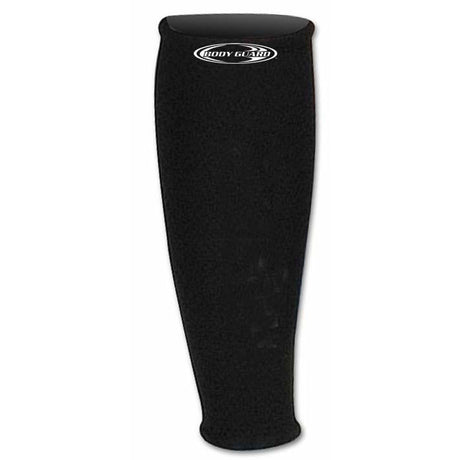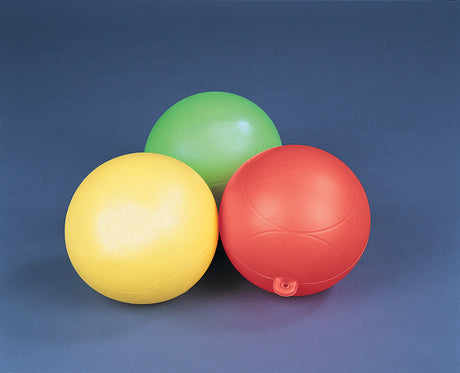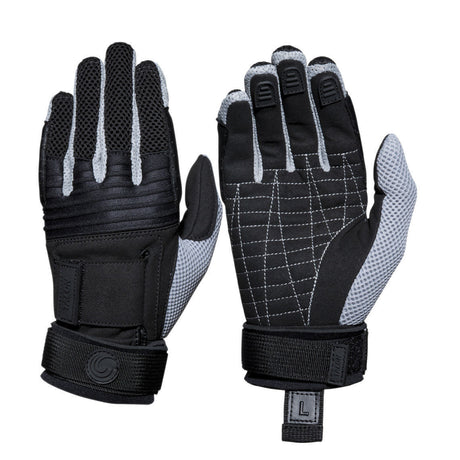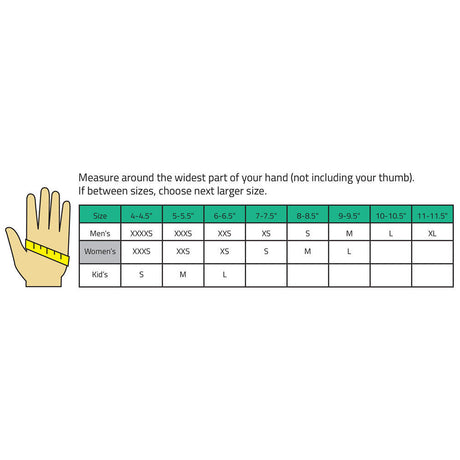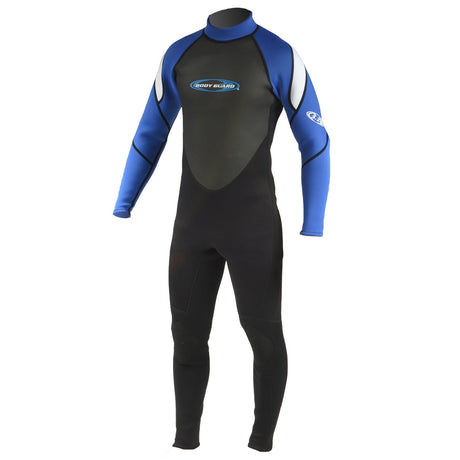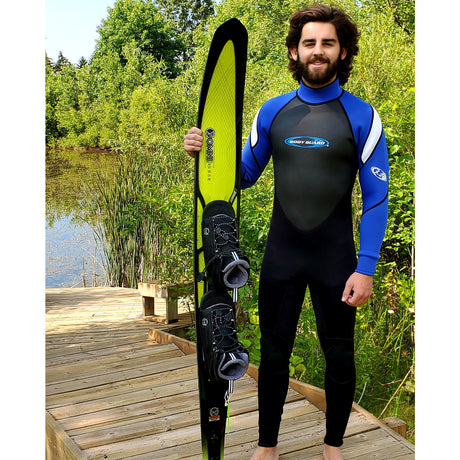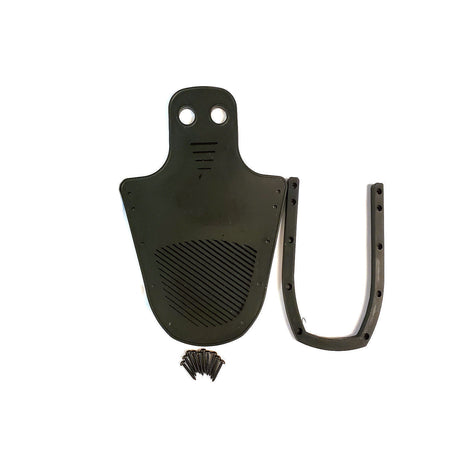Who says you have to stow the boat and hit the slopes when the temps get chilly? There's no need to ditch your tow rope for a ski lift! Plenty of water skiers and wakeboarders simply keep on riding as the seasons shift, with no risk of injury or hypothermia.
So long as you get the right gear and head out in the right conditions, you can water ski, wakeboard, and generally stay on the water for most of the year.
That last part is key. We're covering what gear you need to stay warm, how long you should stay in the water depending on conditions, and minimum safe water and air temperatures. Let's go.
Wearing the Proper Cold-Water Gear
Board shorts and tank tops won't cut it in November. You're going to need a wetsuit, at minimum.
Wetsuits vs. Dry Suits
Some folks can get away with wearing a warm-weather "shorty" wetsuit, but chances are you'll need at least a 4/3mm suit. In some cases, you'll need a full dry suit. Not sure which one's which?
Winter-Rated Wetsuit
A wetsuit traps a thin layer of water between your body and the suit, which warms up with your body heat. Once warm, the water itself acts as an effective insulator.
When it comes to cold-water water skiing or wakeboarding, a 4/3 suit is the minimum recommendation. A 5/4 suit is even better and, in some cases, a 6/5 suit's needed for those raw winter days.
"What's a 4/3 or 5/4 wet suit?"
Excellent question! A 4/3 suit refers to the thickness of the neoprene material that makes up the suit. In this case, the torso of the suit measures 4mm thick. The arms and legs measure 3mm thick.
The same logic applies for a 5/4 suit: The torso's 5mm, and the limbs are 4mm. The thicker the neoprene, the greater the insulation.
You probably guessed it by now, but a 6/5 suit has a 6mm torso and 5mm limbs.
"Which suit's needed for cold temperatures?"
A 4/3 suit is rated for water temperatures down to 52 degrees Fahrenheit (11 degrees Celsius). A 5/4 suit is rated for water temperatures down to 46 degrees Fahrenheit (8 degrees Celsius), and a 6/5 suit's rated for temperatures between 44 degrees Fahrenheit (7 degrees C) and freezing (32 degrees F, or 0 degrees C).
It's important to note these ratings are for water temperatures. When you're engaging in towed water sports during cold weather, the air temperature plays a key role in what gear you need to wear, too.
That's why a dry suit might be required instead.
Dry Suit
Dry suits keep you completely dry when you're skiing or boarding. There is no layer of water that enters the suit, resting between your skin and the suit itself.
When water temperatures fall below 50 degrees Fahrenheiht, or when air temperatures are around the same range or below it, a dry suit may simply be required.
This is because the added wind chill from being towed behind the boat may overpower the insulation of a typical wetsuit.
Closed-Toe Bindings
Whether water skiing or wakeboarding, closed-toe bindings are practically required in cold water. Like a wet suit, they'll provide some level of "wet" insulation against the water and wind chill.
Grab closed-toe ski bindings here.
Grab closed-toe wake bindings here.
Additional Gear
When you're water skiing or wakeboarding in cold weather, you'll need to take frequent breaks. You're going to be spending nearly as much time on the boat as you will in the water -- that means having additional warming gear onboard.
Warm Clothes
Always bring extra warm clothing on the boat. Toweling off and throwing on a hat, gloves, a thermal top, and a fleece jacket will provide extra protection against hypothermia in between runs.
Hand and Feet Warmers
Disposable or reusable warmers can help keep your digits comfortable. Consider wearing neoprene booties and gloves for added insulation, and stick with closed-toe bindings.
Safe Combinations of Water and Air Temperatures
The combination of water and air temperatures can significantly affect your safety. A combination of at least 60°F water and 50°F air is generally considered safe for water sports with minimal gear.
If the water is 55°F (13°C) and the air is below 50°F, be cautious and only wear a heavy wetsuit or dry suit, as conditions can lead to rapid cooling and hypothermia.
How Long Can You Stay in the Water?
Your tolerance to cold, in addition to actual temperatures, will dictate how long you can safely remain in the water. Seasoned cold-water skiers and wakeboarders can spend up to an hour on the water, depending on conditions.
Beginners should aim for shorter stints in the water. Take frequent breaks between runs. It can be difficult to feel your hands and feet getting too cold, so it's important to set stop times and assess your physical condition before continuing.
Duration Guidelines
As a general rule of thumb, in 60°F (15°C) water, you may be comfortable for 30 to 60 minutes. In colder conditions, limit your time to 15 to 30 minutes and always take breaks to warm up.
Many skiers and wakeboarders use the "100" rule: If the combination of water temperature and air temperature equals a value of at least 100, it's generally safe and relatively comfortable to go out on the boat with a wetsuit.
For any value below 100, take extra precaution, stay in the water for shorter periods of time, and consider wearing a full drysuit instead of a wetsuit.
Other Precautions
Safety is paramount when engaging in cold-water water skiing and wakeboarding. Here are additional precautions you need to take every time you go out.
Life Jackets
When water skiing, wakeboarding, or engaging in any other towed water sport, a life jacket is required in virtually all 50 states' public waters. A life jacket's even more important when you're riding in cold water.
In addition to preventing drowning, your life jacket will act as a second effective layer of insulation for your torso, helping to maintain your core body temperature.
Buddy System
Sudden submersion in cold water can cause involuntary muscle contractions and an inhalation response, which greatly increases the risk of drowning.
Always ski or board in cold water with at least one boat operator, plus an additional passenger who's available at all times to act as a rescue person. This ensures someone can assist you if you experience shock, paralysis, or confusion from a severe wipe-out.
Monitor Weather Conditions
Keep an eye on changing weather, which can rapidly affect water and air temperatures. Skiing and boarding in high winds should also be avoided, as the wind chill factor can be dangerous.
Stay Hydrated
Even in cold weather, hydration is important. Drink warm fluids to help maintain your body temperature in between runs. Bring a coffee pot or thermos with you, and have a hot cup of coffee or tea to help maintain your core body temperature.



